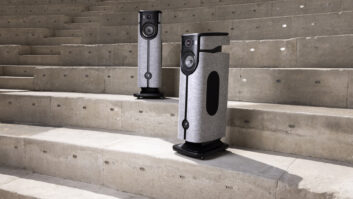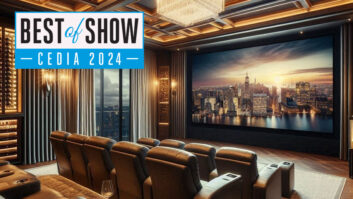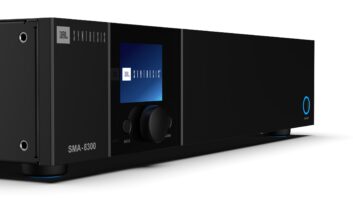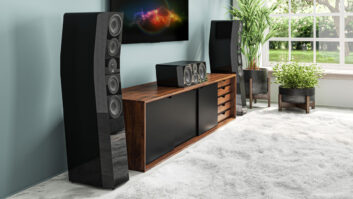 Philip Jones is the director of training at Sound United and is responsible for developing training content and sales tools to support the multiple Sound United brands throughout North America. He works directly with the engineering and marketing teams to create training materials and retail tools to effectively highlight the benefits of Sound United’s product lineup, which includes such brands as Denon and Marantz. Previously in his career Jones has been a retail trainer for Tweeter, performed national training for Yamaha, and was the product technology manager for Sony Home Entertainment.
Philip Jones is the director of training at Sound United and is responsible for developing training content and sales tools to support the multiple Sound United brands throughout North America. He works directly with the engineering and marketing teams to create training materials and retail tools to effectively highlight the benefits of Sound United’s product lineup, which includes such brands as Denon and Marantz. Previously in his career Jones has been a retail trainer for Tweeter, performed national training for Yamaha, and was the product technology manager for Sony Home Entertainment.
So he knows surround sound, and shares some of that knowledge here.

Let’s begin our discussion on the state of surround by looking at where we’ve been. Originally, when you had a multichannel music format, it was based on number of channels. There was Dolby Pro Logic, which was basically multiple channels of music wrapped into two channels, and then we had 5.1, 7.1, and then they went to 9.1 channels. And each time there was a new surround sound or video format you had to replace your receiver.
Current formats such as DTS:X, Dolby Atmos, and IMAX Enhanced are object-based surround sound formats. Instead of it being mixed for a specific channel, it’s literally mixed for a location in space. If you were to go to the recording studio or the mixing room, engineers have this joystick where they can determine exactly where they want that sound to be located in space to the left, right, and above your head. Once they put it there, that location is embedded into the signal, and when you play it back on an IMAX, DTS:X, or Atmos system, the software will look at the speakers it has available and determine how to use those speakers to give you the impression that the sound is coming from that location.
There is no longer a need to continuously upgrade your AV receiver to add new surround sound formats. If you have an Atmos receiver, you start off with 5.1.4. — you have five surround speakers and four height speakers to make that object come from that location. Then, say in five years, you update to 7.1.6. The file is still the same, but now the receiver can use seven surround sound speakers and six height speakers to come up with that location. If a chipset comes out and it’s 32.1.24, the receiver would still have the capability to do that.
Related: IMAX Enhanced Investigated
Talking Formats
Right now, the two biggest formats are DTS:X and Dolby Atmos. Then you have IMAX Enhanced and formats like Auro 3D, which is popular in other countries and provides a great experience for music. Auro 3D is a channel-based format, unlike the object-based DTS:X and Atmos. However, it does have some cool things.
With object-based formats, there’re two layers of sound — a surround layer and a height layer. You have your six speakers in the ceiling above you and your seven speakers on the floor. Auro 3D is actually three layers — a surround floor layer, a ceiling height layer, and then there’s a speaker directly above you called the “Voice of God.” Auro 3D recordings are made using multiple microphones in a live environment, and then they can re-create that environment very realistically in your home. It can also be mixed in movies.
IMAX Enhanced is owned by Xperi, who is also the owner of DTS and IMAX. IMAX material was always mixed differently than if you went to a normal movie theater because their speaker layouts are different, plus there’s a difference in screen size. So all this material has been mixed specifically for IMAX, but it was never released for the home. Now, because the two companies are together, DTS:X can be used to position the speakers virtually in your room as if you were in an IMAX theater.
Remember: We’re not talking about channels anymore — we’re talking about positions of audio objects. I can position that sound in the same place it is for DTS:X or I can position it for IMAX. The impression in the room is different. With IMAX, it has a little bit more punch to it.
Which one’s best for the consumer is up to them. The nice thing for customers is that now they have more choices. There may be two different versions of the movie and they could pick the one they like best — or both.
Most of the content currently available today is either in Atmos or DTS:X. Those are the two that the studios decide they want to use, and it’s up to them which way they mix it. They may make the movie in both versions, but only release it in one of them. IMAX Enhanced is a different mix that’s overlaid onto DTS:X as backward compatible. An IMAX Enhanced disc has another layer on it that is just DTS:X, so you can choose between the two.
Kaleidescape has a tremendous amount of Atmos and DTS:X content because those are the 2000-pound gorillas in the industry right now; it just depends on how the studio distributed the movies to them. Currently there is no IMAX Enhanced content available on Kaleidescape, but it doesn’t mean it can’t be added in the future since it is based on DTS:X. You will see a lot of IMAX Enhanced movies streaming because it’s a better business model for many studios instead of releasing a secondary disc.
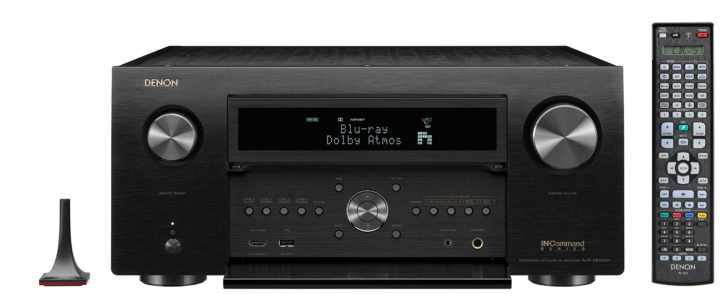
The Right System for the Room
What’s nice now is that most of the systems can utilize the same speaker configuration because they’re object based. You don’t have to worry about different speaker placements for each system.
There are some minor adjustments — like slight angle changes for each speaker — in the recommendations between DTS:X and Atmos. But, as a dealer, you don’t have to worry — it’s so close that if you make the room sound great for Atmos, it is going to sound great for DTS:X and vice versa.
The main thing you have to ask clients is where can you have positions to put speakers and, from there, if they’re open to having multiple speakers in the room. Then you can get to what’s the best place to get the effect they want. For example, most modern homes are wired for ceiling speakers. If there’s no place to put ceiling speakers, then you would put the height-channel speakers on top of the floorstanding speakers and bounce it off of the ceiling.
I’ve noticed the sweet spot with customers is 5.1.4 or 7.1.4, and that works for every format.
The Importance of eARC
Audio-wise, we’re pretty good as far as equipment updates go because DTS:X and Atmos are going to be around for a while. It’s a different story on the video side. Most of the better receivers will support current 4K HDR capabilities. In video, you need to have at least the ability to pass 18 gigabits per second. If it can pass 18 gigabits per second, it’ll pass the maximum quality of any video source available today.
There are going to be new video capabilities coming — it’s already been announced. It’s called HDMI 2.1, which offers a massive jump in bandwidth from 18 to 48 gigabits per second. It’s designed to support up to 8K at 60 frames per second or 4K up to 120 frames per second. It’s going to be a long time before there will be any content that utilizes that spec, because TV and movie studios are currently not producing content, television stations are not broadcasting it, and there’s no physical media yet announced to support it.
The only sources in the near future that may utilize the higher frame rate and 8K resolution are game systems — maybe the upcoming PlayStation and Xbox. The new HDMI 2.1 spec allows support of super high frame rates and super high-resolution video gaming. In addition to high bandwidth, HDMI 2.1 also has a bunch of convenience features, and one of them is eARC. As an installer, you need to make sure that the AV receiver has eARC in it, which stands for “enhanced audio return channel.”
Right now, if these gaming systems show up and the client has a 4K TV with the proper HDMI 2.1 inputs, they would plug that game system into the TV directly and then they would feed the audio from that game from the TV back to the receiver using the HDMI cable that’s connected between the two. The TV will send uncompressed Atmos, DTS:X, or IMAX Enhanced back to the AVR via eARC.
If you’re not preparing for an HDMI eARC-based install, you are burning yourself. A lot of times installers are afraid of ARC and eARC — they don’t like to use it because HDMI ARC used to be connected to CEC — consumer electronics control — where the HDMI ARC would hijack your control system and the TV would try to control the receiver or vice versa. Now most TVs and AVRs allow you to separate the two, so you don’t have to have the CEC turned on to use HDMI ARC capabilities.
If you don’t use ARC or eARC, the only other option would be an optical output from the TV to the receiver, but that only passes Pro Logic, so you can have this beautiful TV with Netflix with Dolby Vision and Atmos on it, and all you’re going to get back to the receiver is stereo or Pro Logic.
You have to get used to it — if you don’t, in the future when that person does get that 8K gaming system to go with that HDTV, and he wants to send that sound back to the AVR, it’s not going to come back as surround sound and the customer is not going to be happy. Even if you don’t use it today, you need to make sure the backbone of your system supports it.
And the future is not that far off. The first streaming source that’s available on the market right now for IMAX Enhanced is a service called Privilege 4K and it is available on select Sony TVs. The only way to get the full audio benefits of that service from the TV to your receiver is eARC.
Another thing that’s available right now, particularly for gaming, is auto low latency mode. When gaming content is detected, the TV and AVR will automatically switch in their gaming mode for a lag-free gaming experience.
Related: Home Theater Sound’s Next Wave
Selling Surround Sound
When it comes to selling surround sound, and if you have space for a demo system, you want to set up an Atmos or DTS:X system. Again, the formatting for both of them are compatible with each’s speaker placement, so if you could do a traditional surround and in-ceiling type system, please do. That’s going to give you the best effect.
Many times 5.1.4 gets the gets the point across quickly — adding more channels than that in a retail environment does improve the impact, but it isn’t as dramatic as that original step from 5.1 to 5.1.4. If you cannot do speakers in the ceiling, you can do a demo with height-enabled speakers. Those would be the the speakers that sit on top of the floorstanding speakers and bounce the sound off of the ceiling — especially if your ceilings are less than 14 feet.
If you can’t do that, then both the Denon and Marantz have models that offer virtual height modes for DTS:X and now Dolby Atmos, so you can give clients the impression of the height virtually even if you don’t have height speakers in the ceiling. And if you can’t do that, at a minimum, have an Atmos soundbar.
The moral of the story is do not remove, reduce. Give the customer the effect so they can be shown a better experience; something different that is worthwhile. Do not remove, reduce also applies to the customer’s home. Try to find the most efficient way to provide the best solution based on the customer’s budget as well as their layout.
There’re tons of great demo discs you can use — DTS:X and Dolby Atmos release great demo discs each year. There are also several great movies out there like Men in Black: International and Spider-Man: Into the Spiderverse. Kraftwerk has a Blu-ray concert video that’s an amazing use of Atmos and really adds a layer of immersion that you don’t get on a normal system.
Dual Uses — Music and Home Theater
Speaking of music, most customers do not have the the ability to have a 2-channel listening room and a multichannel home theater. If you have a nice set of main speakers and a good AVR or preamp-processor with amplification, you can definitely deliver a very high-quality 2-channel experience. If the speaker placement for the mains are placed to sound best for audio, they will also sound great for video. Always setup for 2-channel first, and then overlay the surround sound experience.
The reason why the center channel was even invented was to re-create the beautiful phantom image where the voice will be singing directly in between the two speakers in a dynamic 2-channel system. In a movie theater, not everybody gets to sit in the middle, and in a home theater not everybody gets to sit in the sweet spot. The center channel was developed to enhance the dialog and lock objects in position. So build a good 2-channel system and then all of the multichannel products can fit where they need to be. That’s going to give you the best of both worlds.
Of course, there are times when they may want to hear that 2-channel sound from all their speakers. Obviously the best thing would be to play back something that was mixed in surround, but in lieu of that there are a number of surround sound modes that can do the job.
Dolby Surround has a version, as does DTS, and there is also an Auro 3D upmixer. All three of them give you different impressions and different effects, but they all work really well. It just becomes a preference.
Some receiver manufacturers will also do things such as Church Mode and Arena Mode where they add level of echo or reverb to give you the impression of a bigger room.
It does make music pretty interesting to listen to when you utilize any of these particular modes, or you could just use what’s called five-channel stereo, which basically puts the stereo in the back and it puts anything that’s mixed equally left and right into the center channel.
Final Word
Many times people don’t realize how much of a difference quality components make, even if you’re not doing a surround system. Fortunately, it is pretty easy to show them.
I was speaking with a dealer who told me his technique for showing clients the difference quality sound makes. Most customers now have some sort of little portable music speaker — an Amazon Alexa, a Google Home, and so on — and this dealer has a little rolling case with a pair of bookshelf speakers and an AV receiver. He asks them to give him five minutes to show how much of a difference better quality audio is going to make in their life, and he has them play a song on their little smart speaker. He then takes two speakers out of the case and, using his phone for the music service, he plays back the same song he just had the customer play on a small set of bookshelves with an AV receiver.
Lo and behold, the difference is just insane. And if it does that much for music, imagine what it is going to do when you watch television.
It’s a simple investment, and it works amazingly well to show why audio is important and why the customer should add better sound to their homes.

